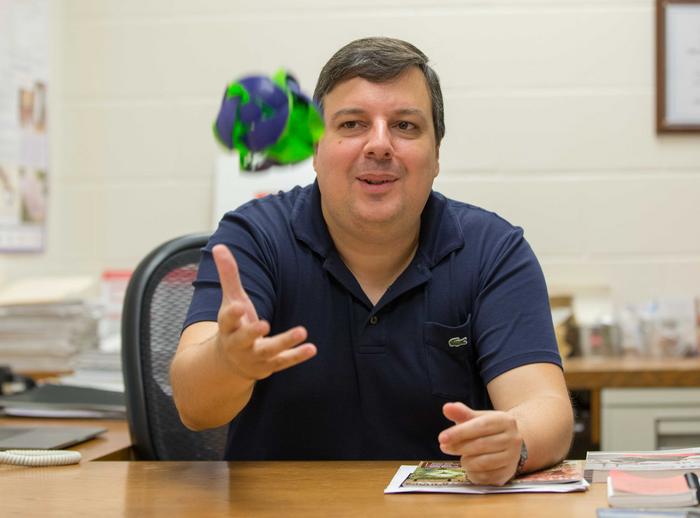The University of Cincinnati is taking center stage this week as it hosts a pivotal workshop set to shape the future of high-energy physics research. The gathering converges leading minds and rising stars from across the globe to deliberate on the next decade of neutrino science, a field that probes some of the universe’s most enigmatic and elusive particles. Central to this workshop is the quest to unravel the mysteries of neutrinos, subatomic particles so minuscule and abundant that trillions pass through every human being every second, nearly at the speed of light.
At the heart of this initiative is UC Physics Professor Alexandre Sousa, whose work has been instrumental in framing the global research agenda for neutrinos over the next ten years. Neutrinos, often described as “ghost particles,” interact incredibly weakly with matter, making their detection and study profoundly challenging. However, their properties hold keys to mysteries beyond the current Standard Model of particle physics, potentially opening windows into uncharted physical phenomena. Sousa’s research group is actively engaged in both theoretical and experimental fronts to bridge these gaps.
.adsslot_804Me3FfUi{ width:728px !important; height:90px !important; }
@media (max-width:1199px) { .adsslot_804Me3FfUi{ width:468px !important; height:60px !important; } }
@media (max-width:767px) { .adsslot_804Me3FfUi{ width:320px !important; height:50px !important; } }
ADVERTISEMENT
This global collaboration includes contributions from large-scale experimental facilities like CERN’s Large Hadron Collider and the Deep Underground Neutrino Experiment (DUNE), an ambitious project situated in a repurposed South Dakota goldmine nearly a mile beneath the Earth’s surface. This subterranean location shields neutrino detectors from cosmic radiation and background noise, thereby providing pristine conditions for ultra-sensitive measurements. DUNE represents one of the most comprehensive efforts to date, involving over 1,000 scientists and engineers worldwide.
Professor Sousa emphasizes the broad participation of early-career researchers in this workshop, highlighting the vital role of fresh perspectives and innovative methodologies. The infusion of young talent in high-energy physics is crucial as many foundational experiments enter new phases of operation and data collection. Early-career physicists, including postdoctoral researchers like Sousa’s own Luiz Prais, are poised to become future leaders, advancing both theory and experiment in this frontier field.
The neutrino’s elusive nature stems from its very weak interaction with matter. Unlike charged particles, neutrinos slip through entire planets almost unimpeded. This ghostly trait makes them inherently difficult to detect, yet it also means their behavior preserves pristine information about the cosmic events that produce them. From the nuclear furnace of the Sun to the radioactive decay within Earth’s crust, and even in high-energy collisions engineered in particle accelerators, neutrinos carry unique signatures that could unravel the dynamics of the cosmos.
Interestingly, subtle experimental anomalies have cropped up in recent decades, sparking intense debate in the scientific community. These puzzling results hint at phenomena that current models cannot adequately explain. Some discrepancies suggest the existence of additional neutrino types or unknown forces at play, motivating new proposals and experimental designs featured prominently in the workshop’s agenda. By consolidating global expertise, researchers hope to validate or dispel these anomalies through next-generation detectors and methodologies.
Beyond neutrino-focused research, the workshop highlights the synergy between neutrino experiments and other high-energy physics endeavors. Notably, the Large Hadron Collider and other international laboratories contribute complementary insights, fostering a holistic approach to probing fundamental particles and interactions. These collaborative efforts enhance data interpretation, theoretical modeling, and technological innovations necessary for pushing the boundaries of particle physics.
The upcoming decade promises a transformative era for neutrino physics. Enhanced detection technologies, sophisticated data analysis techniques, and multinational collaborations coalesce to push the envelope of precision and discovery. The outcomes of this research have profound implications, from understanding matter-antimatter asymmetry in the universe to informing theories about dark matter and energy. The University of Cincinnati’s workshop stands as a beacon in this grand scientific journey, assembling the talent and ideas that will chart the way forward.
As the Deep Underground Neutrino Experiment gears up for its official launch in 2031, incremental advances and testing phases underway today lay the groundwork for its success. Such large-scale experiments require meticulous site preparation, intricate detector calibration, and coordinated international effort. The patience and precision exercised in this process underscore the scientific community’s commitment to resolving some of the most profound questions in physics through sustained inquiry and collaboration.
In summary, the University of Cincinnati’s role in hosting this workshop not only highlights its leadership in the global neutrino research community but also underscores the importance of nurturing the next generation of physicists. These discussions and collaborations are more than academic exercises—they form the cornerstone of scientific progress that may one day rewrite the fundamental laws governing the universe’s most basic constituents and forces.
Subject of Research: Neutrino physics and the future direction of high-energy particle physics research.
Web References:
Journal of Physics G article: https://iopscience.iop.org/article/10.1088/1361-6471/ad307f
University of Cincinnati news on neutrino research: https://www.uc.edu/news/articles/2024/12/uc-physicists-outline-next-10-years-of-neutrino-research.html
Image Credits: Joseph Fuqua II
Keywords
Physics, Particle physics, Neutrinos, High-energy physics, Particle accelerators, Deep Underground Neutrino Experiment, Standard Model, Sterile neutrino, DUNE, Fermilab, Large Hadron Collider, Experimental physics
Tags: Alexandre Sousa contributionsfuture of particle physicsghost particles explorationhigh-energy physics researchinternational physicists collaborationmysteries of the universeneutrino oscillation studiesneutrino science advancementsnext decade in neutrino researchsubatomic particle detection challengestheoretical and experimental physicsUniversity of Cincinnati workshop





